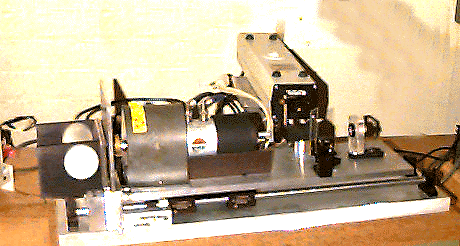|


The Mössbauer effect and some
of its applications in ultra-high resolution , , gamma-ray spectroscopy are explored. The Zeeman
splittings, quadrupole splittings, and chemical
shifts of the 14 keV Mössbauer gamma-ray line
emitted in the recoilless decay of the first excited
state of the 57Fe
nucleus are measured in iron and in various iron
compounds and alloys.
, gamma-ray spectroscopy are explored. The Zeeman
splittings, quadrupole splittings, and chemical
shifts of the 14 keV Mössbauer gamma-ray line
emitted in the recoilless decay of the first excited
state of the 57Fe
nucleus are measured in iron and in various iron
compounds and alloys.
From the data and knowledge
of the magnetic moment of the 57Fe
ground state one determines the magnetic moment
of the first excited state, and the strengths
of the magnetic field at the sites of the iron
nuclei in metallic iron, Fe2O3,
and
Fe3O4.
The
natural line widths of the 14 keV transitions
are determined from measurements of the absorption
line profiles in sodium ferrocyanide absorbers
of various thicknesses. Relativistic time dilation
is demonstrated by a measurement of the temperature
coefficient of the energy of the 14 keV absorption
lines in enriched iron.
Student Wiki: Mossbauer Spectroscopy
Download
Lab Guide in PDF format
(certificates
required)

- S. De Benedetti, "The
Moessbauer Effect", Scientific American, April,
pp.72-80, (1960)
- S. De Benedetti, G. Lang, and R. Ingalls, "Electric Quadrupole Splitting and the Nuclear Volume Effect in the Ion of FE57", Physical Review Letters, V6N4, January, pp. 60-62, (1961)
- S. L. Ruby, L. M. Epstein, and K. H. Sun, "Moessbauer
Effect in Ferrocyanide", Review of Scientific Instruments,
31, pp.580, (1960)
- Nobel
Lectures from Robert Hofstadter and Rudolph Ludwig Moessbauer [1961]
- A. J. F. Boyle and H. E. Hall, "The
Moessbauer Effect", Reports on the Progress
of Physics, pp. 441-524, (1962)
- H. Frauenfelder, The
Moessbauer Effect: A Review with a Collection of Reprints,
(New York, W.A. Benjamin, Inc., 1962)
- O. C. Kistner and A. W. Sunyar, "Evidence
for Quadrupole Interaction of Fe57 and Influence of Chemical Binding
on
Nuclear Gamma-Ray Energy", Phys. Rev. Lett., 4,
pp. 412-415, (1960). note:Better copy than the one in Frauenfelder
- R. S. Preston, S. S. Hanna, and J. Heberle "Mossbauer
Effect in Metallic Iron", Phys. Rev., 128, Number
5, pp. 2207-2218, (1962)
- J. King ed., Moessbuaer
Effect: Selected Reprints, American Institute of Physics (1963), Addendum
to Reprints, (1963)

- Mössbauer Spectroscopy International Organizations
- Mössbauer Spectroscopy Schematic
- MIT
Department of Chemistry
- Mössbauer Links
- ASA - S700A Mossbauer Drive
- ASA -S700A Initial
Checkout Manual
- OxfordWin Software V3.80
(18,530kB)
- ASA PC-200 Proportional Counter Detector
- Ortec 109PC Proportional Counter Preamplifer
- Canberra 3002D HV Power
Supply
- Canberra 815 Amplifier - No Manual Available
- Melles Griot 05-LHR-111 Cylindrical He-Ne Laser
- MIT Low Frequency Amplifier
- Omega CN5001J1-F2 Temperature Controller - J Type Thermocouple Sensor 0-650C
Setpoint
- Sample Heater
|